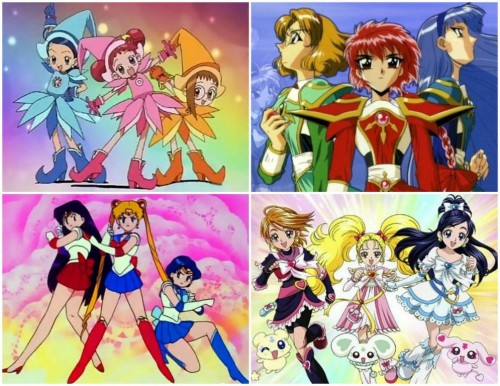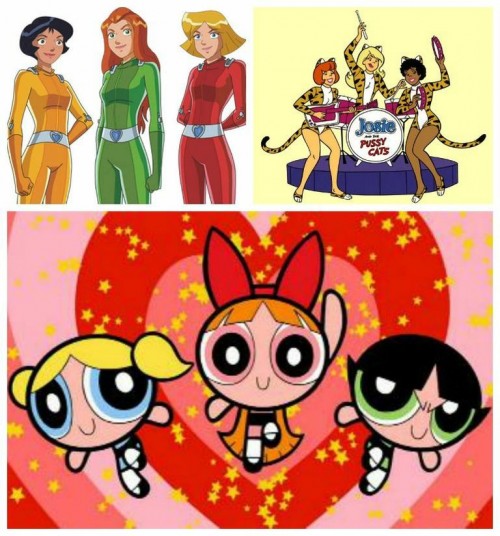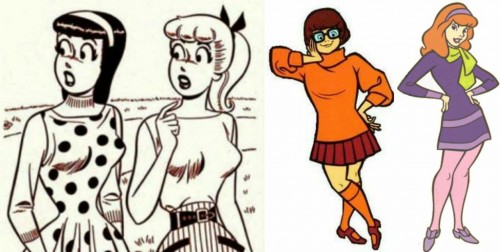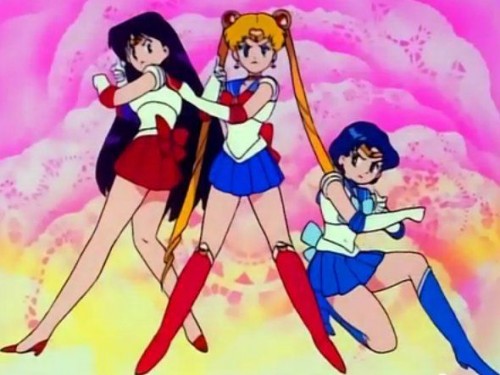This guest post by Emanuela Betti appears as part of our theme week on Children’s Television.
One of the oldest tropes in children’s TV is the use of characters that fight or solve crimes as an ensemble. Most notably, the Power Trio, or the three character group, is a popular formula in numerous cartoons and TV shows, from Sailor Moon to the Powerpuff Girls. There are very distinct differences in the depiction of female characters between the two-girl tag-along formula, which you can see in The Archie Show or Scooby-Doo, and the three girl ensemble formula in shows such as The Powerpuff Girls.
One of the most recognizable female duos in children’s entertainment are the iconic frenemies from the Archie comic books and The Archie Show, Betty and Veronica. Despite their mutual adoration of Archie, the two girls are almost polar opposites: Betty is the tomboyish, girl-next-door blonde, while Veronica is the sultry, high-maintenance brunette; Betty is sensitive and caring, while Veronica is often depicted as cold-hearted and manipulative. Female duos in cartoons and children’s TV, such as the Betty and Veronica duality, play on the Light Feminine and Dark Feminine trope: the idea behind the Betty and Veronica duality implies that a woman is a tomboy or a bitch, a sweetheart or a vixen—but never both. The Betty and Veronica duality could be interpreted as safe female vs. dangerous female: the stereotype that the “safe female” (laid-back, tomboy, funny) is un-dateable, while the “dangerous female” is a guy-magnet but incredibly uptight. Another popular female duo in children’s TV can be seen in Scooby-Doo: Velma is the unattractive but intelligent female, while Daphne is the dumb beauty queen. The stereotype is obvious: smart girls are unattractive, and pretty girls will never be smart. When it comes to children’s TV and cartoons, the oversimplification of characters and character traits is usually excusable, but a simplified character doesn’t necessarily have to be a (mostly negative) stereotype.
The problem with dualities—for the sake of contrast—leads to broad generalizations. Mad Men’s “Maidenform” episode, in which the men point out women in the office and classify them as either a Jackie or a Marilyn, is a great example of how women can be easily placed in distinct categories; but generalizations are not accurate, and they imply that the Jackies can’t share any traits with the Marilyns, and vice versa—but Jackie Onassis was a fashion icon, and Marilyn Monroe used to write poetry, so categorizing women is not always that simple. This either-or depiction of femininity is, to say the least, very limiting. Female duos imply that a girl or a woman cannot favor both beauty and brains, but must choose between one of the two. In a sense, the “duo” (as the word implies) is a two-dimensional representation of the feminine: a woman is either intelligent/safe, or dumb/sexy. What is missing is a gray area.
Power Trios in children’s TV, like duos, are still composed of oversimplified types and characters, yet they also suggest that femininity is not so black and white. Three character ensembles introduce characters types than are on a greyer scale than the polar-extremes of the Light/Dark Feminine trope. In the case of female Power Trios, the formula consists of three characters that respectively represent beauty, brains, and strength. Characters representing beauty are usually ditzy and childish, but they are also sensitive and the mediators (so if they happen to be “dumb” they’re at least depicted with a good heart); characters representing brains are sometimes the group leaders, but also rational without being distant or cold; finally, characters representing strength are usually impulsive and hot-headed, but their rash tendencies are balanced out with a loyal nature.
There are countless TV shows and cartoons that feature three girl ensembles, not to mention five girl ensembles, which are an almost different story. Although the trope is typically reserved for children’s entertainment, it has leaked into teen and adult movies and TV shows as well, such as Charlie’s Angels and Charmed. Female Power Trios are extremely prominent in anime, with Sailor Moon paving the way for color-coded magical warriors or witches, and Western animation following suit with shows such as Powerpuff Girls and Totally Spies.
Anime has countless examples of power group/ensemble series. The Power Trio in female-oriented anime was widely popular with the Magical Warriors anime subcategory, most notably with Sailor Moon. While the completed Sailor Senshi group is composed of five girls, the majority of the first season focuses on the trio composed of Usaki/Moon, Amy/Mercury, and Rei/Mars—respectively, they represent beauty, brains, and strength. The last two girls to join the group, Makoto/Jupiter and Minako/Venus, represent a blend of two of the three traits: Sailor Jupiter is a tough fighter, but at the same time also sensitive and easily infatuated; while Minako is similar in appearance to Usagi, but is more level-headed and rational. Several other anime series, some inspired by the Sailor Moon craze, feature color-coded female Power Trios (some turn into five character ensembles): Futari wa Pretty Cure, Tokyo Mew Mew, and Ojamajo Doremi, to name a few. Western animation has its own good share of female Power Trios. Josie & the Pussycats, Totally Spies! and The Powerpuff Girls all follow the same structure: sassy redhead as group leader, tough no-nonsense brunette, and childish but sensitive blondes. Even Australian TV with H2O: Just Add Water features a milder version of the Power Trio with three teenage mermaids who each represent one of the three traits.
The Power Trio females typically feature characters with abilities that are valued in their own distinct forms, rather than basing their personal advantage (beauty/brains) through comparison with their opposite (dumb/ugly). In that sense, Power Trio are better than the two-girl formulas, since trios rely on teamwork and collaboration, rather than rivalry. Unlike the female duos, Power Trios suggest that female characters can possess a larger spectrum of abilities than simply the generalized smart/dumb notion.
Emanuela Betti is a part-time writer, occasional astrologer, neurotic pessimist by day and ball-breaking feminist by night. She miraculously graduated with a BA in English and Creative Writing, and writes about music and movies on her blog.




3 thoughts on “Better Than Two: Female Power Trios in Children’s TV”
Comments are closed.